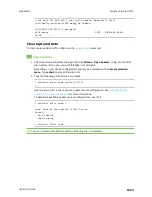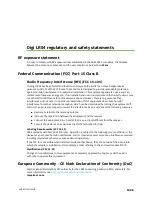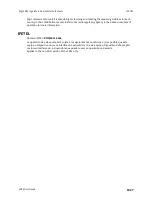
Diagnostics
Use the traceroute command to diagnose IP routing problems
LR54 User Guide
1025
n
ipchecksums
: Calculate ip checksums.
n
max_ttl
: Specifies the maximum number of hops. (Default: 30)
n
nomap
: Do not map IP addresses to host names
n
nqueries
: Sets the number of probe packets per hop. (Default: 3)
n
packetlen
: Total size of the probing packet. (Default: -1)
n
pausemsecs
: Minimal time interval between probes (Default: 0)
n
port
: Specifies the destination port. (Default: -1)
n
src_addr
: Chooses an alternative source address.
n
tos
: Set Type of Service. (Default: -1)
n
verbose
: Verbose output.
n
waittime
: Max wait for a response to a probe. (Default: 5)
Example
This example shows using
traceroute
to verify that the LR54 device can route to host
8.8.8.8
(
) through the default gateway. The command output shows that
15
routing hops
were required to reach the host:
1. Select the device in Remote Manager and click
Actions
>
Open Console
, or log into the LR54
local command line as a user with full Admin access rights.
Depending on your device configuration, you may be presented with an
Access selection
menu
. Type
admin
to access the Admin CLI.
2. At the Admin CLI prompt, use the
traceroute
command to view IP routing information:
> traceroute 8.8.8.8
traceroute to 8.8.8.8 (8.8.8.8), 30 hops max, 52 byte packets
1
192.168.8.1 (192.168.8.1)
0 ms
0 ms
0 ms
2
10.10.10.10 (10.10.10.10)
0 ms
2 ms
2 ms
3
* 10.10.8.23 (10.10.8.23)
1 ms
1 ms
4
96.34.84.22 (96.34.84.22)
1 ms
1 ms
1 ms
5
96.34.81.190 (96.34.81.190)
2 ms
2 ms
2 ms
6
* * *
7
96.34.2.12 (96.34.2.12)
11 ms
11 ms
11 ms
8
* * *
9
8.8.8.8 (8.8.8.8)
11 ms
11 ms
11 ms
>
By entering a
whois
command on a Unix device, the output shows that the route is as follows:
1.
192/8
: The local network of the LR54 device.
2.
192.168.8.1
: The local network gateway to the Internet.
3.
96/8
: Charter Communications, the network provider.
4.
216/8
: Google Inc.
Stop the traceroute process
To stop the traceroute process, enter
Ctrl-C
.






























